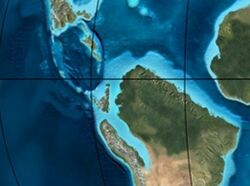Earth:Simijaca Formation
| Simijaca Formation Stratigraphic range: Cenomanian-Turonian ~100–90 Ma | |
|---|---|
| Type | Geological formation |
| Unit of | Villeta Group |
| Underlies | La Frontera Formation |
| Overlies | Chiquinquirá Sst., Churuvita Fm., Hiló Fm., Pacho Fm. |
| Thickness | up to 693 m (2,270 ft) |
| Lithology | |
| Primary | Mudstone |
| Other | Shale, sandstone, limestone |
| Location | |
| Coordinates | [ ⚑ ] : 5°29′15″N 73°50′55″W / 5.4875°N 73.84861°W |
| Region | Altiplano Cundiboyacense Eastern Ranges, Andes |
| Country | |
| Type section | |
| Named for | Simijaca |
| Named by | Ulloa & Rodríguez |
| Location | South of Simijaca |
| Year defined | 1991 |
| Coordinates | [ ⚑ ] 5°29′15″N 73°50′55″W / 5.4875°N 73.84861°W |
| Region | Cundinamarca, Boyacá |
| Country | |
| Thickness at type section | 432 metres (1,420 ft) |
 Paleogeography of Northern South America 90 Ma, by Ron Blakey | |
The Simijaca Formation (Spanish: Formación Simijaca, K2S, Kss) is a geological formation of the Altiplano Cundiboyacense, Eastern Ranges of the Colombian Andes. The predominantly mudstone formation dates to the Late Cretaceous period; Turonian and Cenomanian epochs, and has a maximum thickness of 693 metres (2,274 ft).
Etymology
The formation was defined and named in 1991 by Ulloa and Rodríguez after Simijaca, Cundinamarca.[1]
Description
Lithologies
The Simijaca Formation is characterised by a sequence of mudstones, grey and black shales with sandstone and limestone intercalations.[1][2]
Stratigraphy and depositional environment
The Simijaca Formation conformably overlies the Chiquinquirá Sandstone, and the Hiló and Pacho Formations, and is overlain by the La Frontera Formation.[3] The age has been estimated to be Turonian,[1] or Cenomanian.[4] Stratigraphically, the formation is time equivalent with the Chipaque Formation.[5] The formation has been deposited in an open marine platform setting.[6] The deposition is represented by a maximum flooding surface.[7]
Outcrops
Lua error in Module:Location_map at line 522: Unable to find the specified location map definition: "Module:Location map/data/Altiplano Cundiboyacense" does not exist. The Simijaca Formation is apart from its type locality in the Quebrada Don Lope,[2] found at surface in the north of the Bogotá savanna, in the Tabio anticlinal, along the road Ubaté-Carmen de Carupa,[8] at the western and eastern flanks of the Aponsentos-Chiquinquirá Synclinal,[9] near Tena, south of Anolaima and Cachipay,[10] and between Anapoima and Granada.[11]
Regional correlations
See also
 Geology of the Eastern Hills
Geology of the Eastern Hills Geology of the Ocetá Páramo
Geology of the Ocetá Páramo Geology of the Altiplano Cundiboyacense
Geology of the Altiplano Cundiboyacense
References
- ↑ 1.0 1.1 1.2 Montoya & Reyes, 2005, p.21
- ↑ 2.0 2.1 Acosta & Ulloa, 2001, p.38
- ↑ Acosta & Ulloa, 2001, p.32
- ↑ Acosta & Ulloa, 2001, p.41
- ↑ Montoya & Reyes, 2005, p.22
- ↑ García González et al., 2009, p.209
- ↑ Villamil, 2012, p.164
- ↑ Montoya & Reyes, 2005, p.23
- ↑ Plancha 190, 2009
- ↑ Plancha 227, 1998
- ↑ Plancha 246, 1998
Bibliography
- Acosta Garay, Jorge, and Carlos E. Ulloa Melo. 2001. Geología de la Plancha 208 Villeta - 1:100,000, 1-84. INGEOMINAS. Accessed 2017-03-23.
- García González, Mario; Ricardo Mier Umaña; Luis Enrique Cruz Guevara, and Mauricio Vásquez. 2009. Informe Ejecutivo - evaluación del potencial hidrocarburífero de las cuencas colombianas, 1-219. Universidad Industrial de Santander.
- Montoya Arenas, Diana María, and Germán Alfonso Reyes Torres. 2005. Geología de la Sabana de Bogotá, 1–104. INGEOMINAS.
- Villamil, Tomas. 2012. Chronology Relative Sea Level History and a New Sequence Stratigraphic Model for Basinal Cretaceous Facies of Colombia, 161–216. Society for Sedimentary Geology (SEPM).
Maps
- Ulloa, Carlos E, and Erasmo Rodríguez. 2009. Plancha 170 - Vélez - 1:100,000, 1. INGEOMINAS. Accessed 2017-06-06.
- Fuquen M., Jaime A, and José F. Osorno M. 2009. Plancha 190 - Chiquinquirá - 1:100,000, 1. INGEOMINAS. Accessed 2017-06-06.
- Ulloa, Carlos, and Jorge Acosta. 1998. Plancha 208 - Villeta - 1:100,000, 1. INGEOMINAS. Accessed 2017-06-06.
- Montoya, Diana María, and Germán Reyes. 2009. Plancha 209 - Zipaquirá - 1:100,000, 1. INGEOMINAS. Accessed 2017-06-06.
- Ulloa, Carlos E; Erasmo Rodríguez, and Jorge E. Acosta. 1998. Plancha 227 - La Mesa - 1:100,000, 1. INGEOMINAS. Accessed 2017-06-06.
- Acosta, Jorge E., and Carlos E. Ulloa. 1998. Plancha 246 - Fusagasugá - 1:100,000, 1. INGEOMINAS. Accessed 2017-06-06.
External links
- Gómez, J.; N.E. Montes; Á. Nivia, and H. Diederix. 2015. Plancha 5-09 del Atlas Geológico de Colombia 2015 – escala 1:500,000, 1. Servicio Geológico Colombiano. Accessed 2017-03-23.
 |

